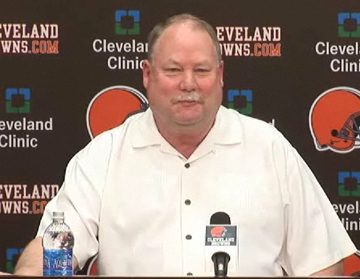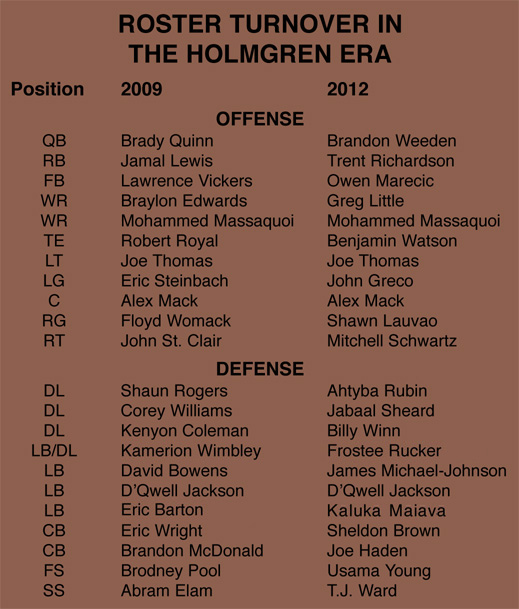 Browns Archive
Browns Archive  The Holmgren Era
The Holmgren Era
 Mike Holmgren is out as president of the Cleveland Browns, and Joe Banner is in. With that news, we look back on “The Holmgren Era,” which lasted from December, 2009 until October, 2012.
Mike Holmgren is out as president of the Cleveland Browns, and Joe Banner is in. With that news, we look back on “The Holmgren Era,” which lasted from December, 2009 until October, 2012.
Since Holmgren’s farewell press conference earlier in the week, the popular media has heaped a fair amount of criticism on his back. “He’s aloof.” “He’s not very involved in the day-to-day operation of the team.” “He hung on to Eric Mangini too long.” “He’s failed to be the team’s spokesman.” “He’s not earned his exorbitant salary.”
So the first question we ask is, Was the Holmgren era as good as the Carmen Policy era, the John Collins era, or the Michael Keenan era? (Admittedly, we’re setting the bar pretty low here.)
Starting at the top of the food chain, you might remember that Policy hired Dwight Clark as general manager; Collins was thrown together with Phil Savage; Keenan’s GM (during a time when there was no team president) was George Kokinis; and Holmgren hired current GM Tom Heckert. History has suggested that Clark was in way over his head; that Savage's strengths were outweighed by his weaknesses; and that Kokinis was a great example of the Peter Principle.
In contrast—although history has yet to be finalized—it appears that Heckert has brought some quality players to a team that was in disarray when he took the GM’s reins from then-temporary “GM” (note quotation marks) Mangini. In that respect, it appears that, yes, the Holmgren era was better than any since the 1999 "return" of the "new Browns."
Although we cannot attribute personnel changes during the last three season to Holmgren, he did have the insight to hire Heckert, and it was during this time that he oversaw all football operations.
It was also during this time that the team’s record went from 5-11 in 2009 to 5-11 in 2010 to 4-12 in 2011 to 1-6 in 2012. The 2009 team scored 245 points and gave up 375 points. This year, the Browns are on track to score 336 points and give up 411 points. So that’s not exactly what you would call a major turn-around.
 The accompanying chart shows the development of the Browns’ starting lineup in two-plus seasons of the Holmgren era. Again, most of the changes can be attributed to the astute drafting of Heckert, but Holmgren was in the draft room those three years and we cannot help but think that his voice was heard once or twice.
The accompanying chart shows the development of the Browns’ starting lineup in two-plus seasons of the Holmgren era. Again, most of the changes can be attributed to the astute drafting of Heckert, but Holmgren was in the draft room those three years and we cannot help but think that his voice was heard once or twice.
Quarterback Brandon Weeden, in his first year, appears to be head and shoulders above Brady Quinn. (Holmgren’s personal favorite during the 2010 draft, Colt McCoy, remains with the team as a back-up.)
Running back Trent Richardson—if he can stay healthy, and that’s a big if—could be every bit the equal of Jamal Lewis, who was at the end of his fine career during the 2009 season. Owen Marecic, however, has been a big disappointment at fullback. Every week, I seem to be thinking to myself, “Oh, for the days of Lawrence Vickers.”
At wide receiver, the current Browns start Greg Little and rookie Josh Gordon, although oft-injured Mohammed Massaquoi is still listed over Gordon on the depth chart. To date, Little has displayed the same characteristics as current NFL journeyman Braylon Edwards: high potential but the inability to make an easy catch. Massaquoi is Massaquoi. Gordon and fellow rookie Josh Cooper, however, give the team more depth at the position. At TE, when he's healthy, Benjamin Watson is no Ozzie Newsome, but he's the best of some pretty good options.
On paper, the current offensive line should be performing better than it is, especially in the running game. All-Pro LT Joe Thomas still anchors it, and high draft pick Alex Mack has been a consistent and stabilizing presence at center. Another high draft pick, Mitchell Schwartz, has more potential than John St. Clair ever had at RT. In 2009, Eric Steinbach was on the downside of his career, but we can’t say that current LG John Greco is any better. At RG, Shawn Lauvao has yet to realize his potential, but he’s at least as good as 2009’s Floyd Womack.
The defense has undergone a huge transformation from Mangini’s 3-4 to current head coach Pat Shurmur’s 4-3. Though the defense enjoyed a fine season in 2011 under Dick Jauron, it has backslid this season and will give up more points than the 2009 team. The big difference is that the 2009 D featured quite a few starters who were agruably over the hill, like Kenyon Coleman, Eric Barton, David Bowens and Brodney Pool. This year’s D has some high-potential younger players; as a matter of fact, the defensive starters have an average age of just 26.0 years, and the only starter over 30 is 33-year-old Sheldon Brown.
We ask again: Has Mike Holmgren been successful as president of the Cleveland Browns during the past three years? Judging by the record, a definite “No.”
But we must not forget that Holmgren has always had a five-year plan to get the team back in contention for a Super Bowl appearance, and that his plan was short-circuited by more than two years. So we ask yet again: Has Mike Holmgren been successful as president of the Cleveland Browns during the past three years? Judging now by the team’s composition, and realizing that it might take two or three more years of good drafting, we see a much brighter future than the day he became president. By that measure, the answer is a qualified “Yes.”
With that fairly balanced but somewhat biased assessment, we bid a fond farewell to The Walrus and say, “Welcome Jimmy Haslam and Joe Banner.”
- NBA Announces 2013-2014 Schedule
- Browns Ink Sharknado
- Sharknado A No-Show For Rookie Camp
- Trent Richardson Out Until Training Camp
- Browns Sign Brandon Jackson
- Carrasco Suspended Eight Games
- Browns Add to Wide Receiver Depth with David Nelson
- Browns Need to Learn from Past Draft Mistakes
- Browns Release Chris Gocong and Usama Young
- Browns Missing on Grimes Disappointing, But Not The End
The TCF Forums
- Official- Browns Coach Search/Rumors
Hikohadon (Tuesday, January 21 2014 1:24 PM) - Movies coming out
rebelwithoutaclue (Tuesday, January 21 2014 12:56 PM) - 2015 Recruiting
jclvd_23 (Tuesday, January 21 2014 12:38 PM) - The 2014 Offseason Thread
Larvell Blanks (Tuesday, January 21 2014 12:25 PM) - Chris Grant's first 3 drafts
Kingpin74 (Tuesday, January 21 2014 10:13 AM) - Mike Brown
YahooFanChicago (Monday, January 20 2014 11:15 PM) - 2014 Hoops Hockey Hijinx
jpd1224 (Monday, January 20 2014 4:44 PM) - 2014 Recruiting
jclvd_23 (Monday, January 20 2014 2:26 PM) - Wish List - #4 Pick
Hikohadon (Monday, January 20 2014 1:26 PM) - #1 overall pick Anthony Bennett
TouchEmAllTime (Sunday, January 19 2014 1:28 PM)



